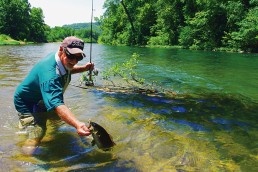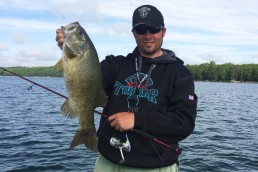Best Baits for Stream Smallmouths
SHARE THIS POST
During decades of float fishing for smallmouths in streams and a few years of guiding fishermen on the upper sections of the North Fork of the White River and on the Black and Current rivers in Missouri, I’ve had more opportunities than most to experiment with baits. You can catch stream smallmouths on a wide variety of lures, but the most consistent smallmouth baits I’ve found are not baits for this species at all—they are ones designed to catch crappies.
One imitates small baitfish and the other small crawfish. That pretty much covers a stream smallmouth’s favorite diet. And I’ve found that by using these crappie-sized lures, instead of even the smallest bass lures, I not only catch more smallmouths in streams but bigger ones as well.
Top of the list is Charlie Brewer’s Crappie Slider, as this is possibly the best imitation of a small baitfish on the market, and is completely snag proof. The other is the small tube jig commonly used by crappie fishermen. Both are fished on light-spinning equipment that handles 6-pound-test line.
The sizes of these baits best represent the dimensions of the natural forage stream smallmouths see most often and accept readily. And, they match the hatch.
The venerable Beetle Spin is a traditional stream smallmouth favorite, and does work well, but I prefer Strike King’s Mini-Kings spinnerbaits, usually fished without a trailer. And some of the biggest smallmouths I’ve ever caught fell for a 1/16-ounce Road Runner with a Mister Twister curly-tail grub. I also like Flukes, but not the big baits largemouth fishermen use in lakes to mimic shad. I’ll then try the same thing for the smallmouths. There are no shad in our rivers and baitfish here are small, so I use little 3-inch Flukes.
My favorite places to fish these are in the tails of riffles, right where the water begins to slow, or in back eddies created off to the sides of the swifter flows where smallmouths are actively feeding. Much like trout, they take up a position behind a rock that breaks the current and allows them to hold without a lot of effort. From this sheltered position they can observe any hapless creature being washed in by the swifter flow.
Are you enjoying this post?
You can be among the first to get the latest info on where to go, what to use and how to use it!
When they spot an edible morsel they dart out into the current, snatch it, and then head back to the calmer feeding position to swallow it. This makes strikes in these areas very solid and easy to detect. Most float fishermen pass swiftly through these areas, concentrating mostly on the quieter and deeper pools between riffles. But this is where everyone fishes. You can catch some bass that way, but when smallmouths are feeding the tails of riffles are where their table is set. That’s where they stack up and make quick, aggressive decisions.
At best, most float fishermen only give these current breaks a passing cast. Most of the time they’re busy maneuvering through the swift water and avoiding rocks that could tip their canoes, so the best way to fish them is to beach the boat below and wade up into the riffle.
Those float fishermen who have never pulled over to wade-fish the tails of riffles will be surprised at how many more smallmouths they can catch if they’re willing to get their feet wet. The best position for fishing eddies is standing in the swift water and level with the eddy so that you’re casting almost directly across the current. Place the bait into the slack portion of the swirling backwater and hold the rod tip high to keep as much line off the water as possible to prevent drag. Keep the line only tight enough to stay in contact with the sinking bait as it drifts through and out of the eddy. Most of your strikes will come right at the edge of the swift current. For tails of riffles, wade to just above the point were the fast water begins to slow and cast, quartering upstream to allow the bait to sink before it reaches the tail. Again, hold your rod tip up and reel just fast enough to stay in contact with the drifting bait. This allows it to sink to the fish’s level as it drifts through the faster water and swings slowly across-stream through the tail of the riffle.
Once the bait begins to swing across the tail, don’t reel at all; you don’t want to retrieve the bait as you might in a pool. But do drift it along, letting the current do the work. Your strikes can come anywhere as the bait drifts through the tail of the riffle, even when the line is straight downstream, so let it straighten out completely and hang there on the current for a second or two before reeling up quickly for another cast.
On wider riffles I’ll start on one side with a short cast, and then lengthen each cast to cover the potential water with longer drifts. Then I’ll wade across the riffle a little farther and repeat these casts in a sort of fan-cast drift, working all the way across the tail.
To catch more smallmouths in rivers, concentrate on the places most floaters ignore and remember that these fish are called what they are for a reason.
MWO
SHARE THIS POST
Did you enjoy this post?
You can be among the first to get the latest info on where to go, what to use and how to use it!
Ron Kruger
Ron Kruger has been communicating the outdoor experience for more than four decades. He has worked as a full-time guide for trout on the North Fork, for crappies and bass on Kentucky Lake and for smallmouths on the Current River. He has served as editor of three outdoor magazines, and owns a patent on a fly/lure called the Desperate Diver.



